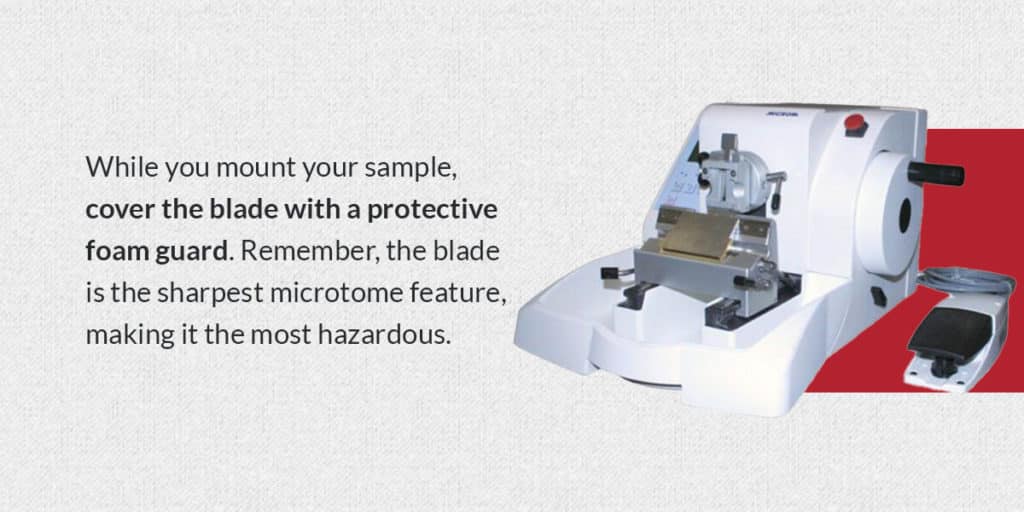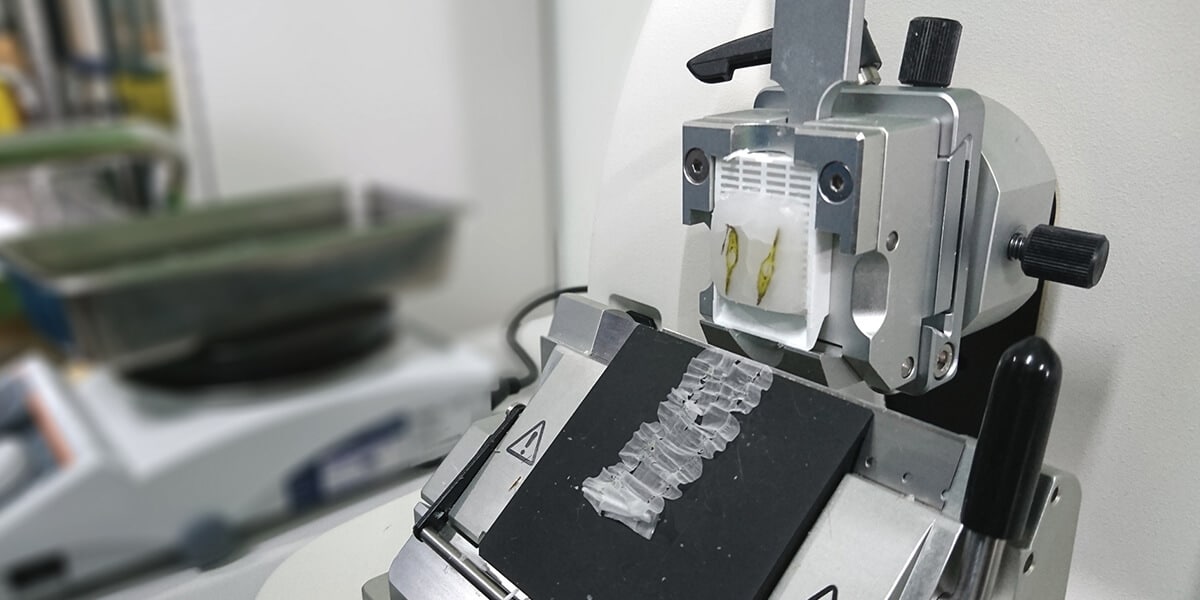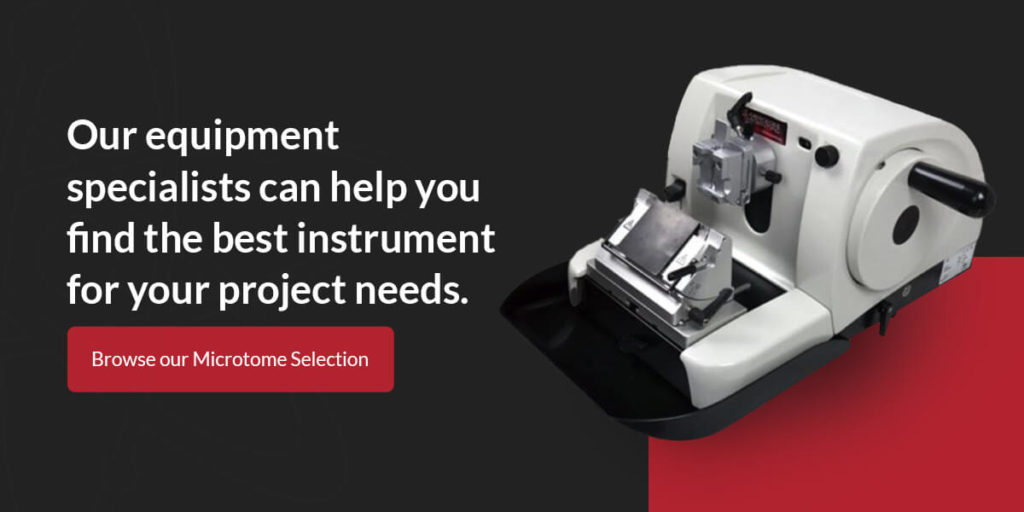Keeping Safe When Using a Microtome
Microtomes are an essential tool for microscopy, allowing you to slice samples into thin strips for examination. Research and clinical lab staff use microtomes to separate samples for biopsies and other critical analyses. The tools help labs get uniform samples quickly and efficiently. You can use a variety of different microtome types to meet specific experimental needs.
Users need to take the proper safety precautions while working with microtomes. The tools feature sharp blades that can become dangerous without safety measures. In addition, microtome use can expose you to infectious organisms or samples. All users should wear protective gear and follow the instrument’s safety guidelines during use to prevent microtome injuries.
Importance of Microtome Safety
Microtomes are crucial tools for many lab procedures, but they present hazards when you uncover their blades and treadles. The tools can function automatically or manually, and accidental activation can result in serious injuries. Using a microtome properly is essential for your health and safety and the protection of the instrument.
To protect users, OSHA released regulations for microtome use in 2012. Be sure you completely understand these standards so you keep yourself protected whenever you use a microtome. Some of OSHA’s guidelines include the following:
- Keep a clearance of at least 1 inch between your hands and the microtome blade.
- Position the foot pedal in the proper position to avoid accidentally triggering it.
- Cover the foot treadle with a cover or guard when not in use.
Before using a microtome, you should receive thorough training from a supervisor. Specific procedures are necessary to protect your hands and fingers. When in doubt, you should ask your lab supervisor or another professional for assistance.
Microtome Safety Guidelines
Following safety guidelines can prevent microtome injuries and enforce a safe laboratory experience. Here are basic safety rules for each step of microtome use:
1. Microtome Setup
Before you operate the microtome, you should follow careful setup procedures. First, users must wear personal protective equipment like:
- Safety glasses
- Lab coat
- Disposable gloves for cleaning
- Cut-resistant gloves for replacing blades
- Covered shoes
While you prepare for microtome use, place forceps and other retrieval tools near the instrument so you can grab them quickly. Never place your hand next to the blade. Instead, use a retrieval tool to withdraw the samples. Another critical aspect of the setup is researching the sample type you’ll work with. Some samples might carry biohazards, so it’s important to be aware of these risks before using them.
Lastly, review the microtome’s manufacturer’s recommendations before operating your microtome. The manufacturer guidelines can provide specific guidance for your brand and machine type. For instance, a rotary microtome might present different hazards than a sledge microtome.
Review the different functions of all buttons and features on the instrument. Remember that OSHA rules should take precedence over the manufacturer ones. If the tool’s instructions oppose the OSHA rules, follow the OSHA ones first.
2. Blade Placement

Once you’ve successfully prepared your microtome for use, you can begin operating it. The first step is to set up your sample. While you mount your sample, cover the blade with a protective foam guard. Remember, the blade is the sharpest microtome feature, making it the most hazardous.
Follow these blade placement steps:
- Set up the tissue block according to your manufacturer’s guidance.
- Set the rotary handle of the block into a locked position while you change blades.
- Insert the new blade into the blade holder using a brush stick — never your fingers. Clamp the blade into place before releasing the rotary handle.
- Once you release the wheel, move the blade toward the block.
- Begin sectioning.
- If you need to change or alter the blade, lock the handwheel and foot pedal before taking action.
- If you have to leave the microtome, put the blade guard in place.
- When you’re ready to retrieve sectioned samples, use brushes or forceps — never use your bare fingers.
Press the stop button if an emergency occurs, and don’t continue sectioning until you resolve the problem.
3. Blade Removal
After you’ve completed sectioning, it’s time to remove the blade from the microtome. Here are typical safety rules of this process:
- Lock the wheels and guard before removing the blade.
- Use forceps or a magnet to retrieve the blade.
- Move the used blade into its proper container — never leave them lying exposed on the table or other surfaces.
- Remove the remaining tissue block.
4. Cleaning Safety
Once you’ve finished using the microtome, you should always sanitize it between sessions. This step is essential for the sectioning process, and it helps ensure the longevity of the tool — properly taking care of your lab equipment keeps it in the best condition possible. You must remove the blade before beginning sanitation procedures.
- Put on protective gloves before cleaning.
- Clean the section waste tray with a dry brush. Remove sample residue and use a water rinse to ensure a thorough cleanse.
- Use a manufacturer-approved disinfectant to clean the microtome. Use a spray bottle to cover the interior components with the disinfectants and let them soak.
- Scrub the instrument with a cloth to decontaminate it.
- Rinse the microtome and let it air dry.
Lastly, you should clean the surrounding work area and ensure there are no leftover tools or sharp objects.
Browse Historologyequipment.com Microtomes Today
You can facilitate a safe and healthy lab environment by abiding by microtome safety procedures. The proper cleaning techniques can keep the instrument in its best condition, eliminating the need for replacements or repairs.
If you need to purchase a new microtome for your lab, choose Historologyequipment.com. We offer a wide selection of new and refurbished microtomes. Our cost-effective and high-quality microtomes can help you perform top-quality analyses. We carry leading brands like:
Our equipment specialists can help you find the best instrument for your project needs. With unlimited after-sales support available, you can ensure you made the correct buying choice. Browse our microtome selection or contact us for more information today.



